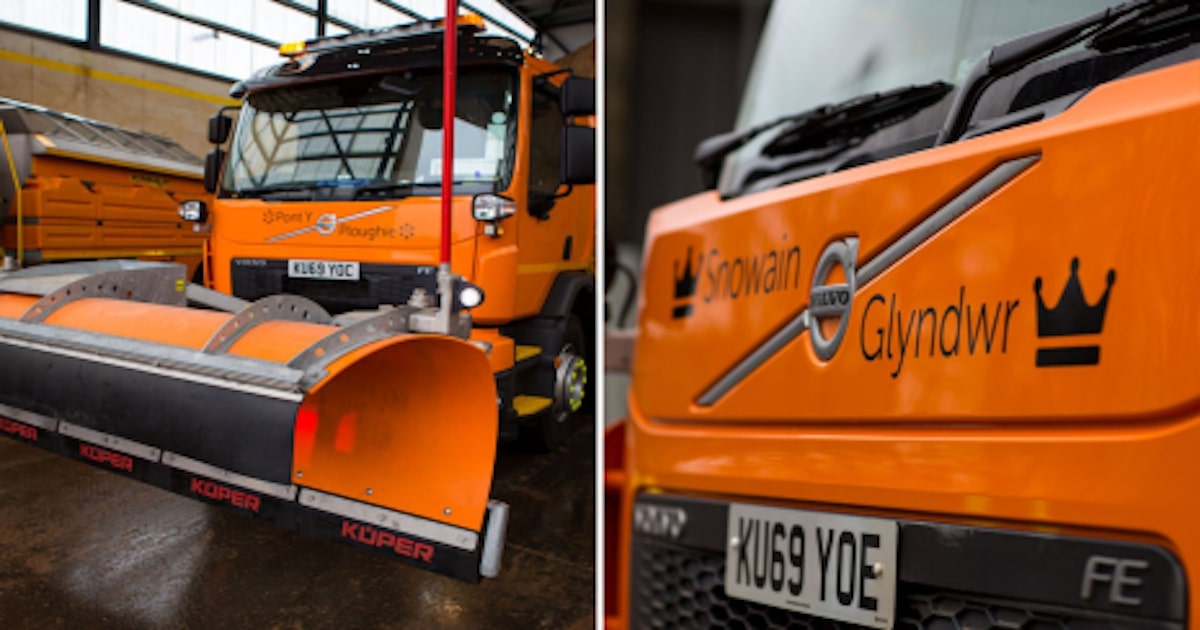The gritters named after Welsh icons given a n-ice twist

As temperatures plummet, Traffic Wales has an army of gritters out on the roads of the nation keeping us safe this winter.
Traffic Wales is the Welsh Government’s traffic information service for motorways and trunk roads in Wales. To help keep motorists on the move, it has 171 gritters based at 39 depots strategically located across the network. A number of which cover the strategic road network, with the gritters in North and Mid Wales working on the county and trunk routes.
Drivers spread grit on the trunk roads and motorway to keep traffic moving safely in colder conditions.
Each year, it operates a winter service from 1 October to the end of April designed to help motorists to continue on their journey safely. Last year, on average, Traffic Wales spent 129 days out of the 212 day winter season gritting the trunk roads and motorway across Wales.
At the start of each winter Traffic Wales replenishes the salt stored in their barns, using this to treat approximately 1900 kilometres of salting routes in Wales. On average, typically 87 nights of spreading salt are carried out during the 212 day winter season.
❄️Gritters will be out across our network tonight. Taking extra care on roads that are vulnerable to ice & driving to the conditions can help you stay safe.❄️
👉https://t.co/43HwCo15uT pic.twitter.com/Q8LtD0bXuh
— Traffic Wales South (@TrafficWalesS) January 10, 2024
❄️Our gritters will be out this evening as we are expecting cold conditions across parts of the network.
🚗When you're on the road, pay attention to the changing road, traffic and weather conditions.
👀Be ready to slow down and take more care if you need to. pic.twitter.com/mJyUg9K52X
— Traffic Wales North & Mid (@TrafficWalesN) January 9, 2024
Staff in the Traffic Management centre operate 24 hours a day. They use road cameras, traffic flow data and road weather forecasts to identify the best time to carry out winter maintenance.
They working closely with Traffic Officers, maintenance partners and the emergency services. They use all this information to decide which areas will be gritted, reduce speed limits and set overhead signs to warn motorists of severe weather and road conditions.
As temperatures have plummeted this week gritters have been out every night spreading salt.
Those eagle-eyed who have spotted Traffic Wales gritters may have noticed that many are named after Welsh icons and winter themes but but given a seasonal twist.
Over the years Traffic Wales has held competitions to name its gritters with hilarious results.

On the Traffic Wales website it names all those gritters with punderful monikers.
They are:
Oh Salt’s Occurring
Snowain Glyndwr
Super Flurry Animals
Fan Halen
Aneurin Bevan
Catherine Gritta Jones
Y Ddraig Oren
Dai Icer
Eira Wen
Cymro
Saltie Bassey
Rob Brrr-ydon
Halenliwia
Jac Codi Rhew
Michael Snow Ma-Sheen
Tanni Grit Thompson
Hedd Wyn-ter
Back in 2021 to honour the NHS, Traffic Wales named one of its gritters after National Health Service founding father Aneurin Bevan.
Thanks for all your brilliant suggestions on what to name our gritters in South Wales.
We wanted to honour the NHS and the efforts of frontline health workers over the past year by naming one of the gritters
Aneurin Bevan – here it is!🌈#NameOurGrittersSW @AneurinBevanUHB pic.twitter.com/TRifU7Wwl0
— Traffic Wales South (@TrafficWalesS) March 17, 2021
Get the nitty-gritty on salt spreaders across Wales’ motorways and trunk roads
Traffic Wales has debunked some of the commonest myths about what is involved to keep the roads clear.
Salt Myth 1: “The roads have been gritted so I can just drive like normal”.
This isn’t true – braking distances are still far longer than in the summer, especially on summer tyres. Drive to the conditions.
Salt Myth 2: “Salt magically makes ice and snow disappear”.
Unfortunately not. Salt mixes with the snow and ice to create brine which has a lower freezing point. It helps to clear ice and soften snow and helps it melt quicker. It still needs traffic to mix and soften it.
Salt Myth 3: “There’s been a collision, you’ve clearly not gritted”.
Our gritters are out whenever conditions require and forecasts are continually being monitored. Regardless of the amount of salt, conditions can still be difficult and driver behaviour has to change to suit.
Salt Myth 4: “The roads are white, you haven’t gritted”
Whilst ice is often white, salt also dries onto the road surface white.
Salt Myth 5: “It’s snowing and the road’s closed, you’re not gritting/ploughing enough”
Unfortunately, once a vehicle becomes stuck in snow and no traffic is moving, the effects of salt reduces and our gritters often have to wait until the vehicles have been recovered.
Salt Myth 6: “There’s snow on the road, you’ve not gritted”
Salt does not prevent snow from settling on the carriageway, especially when falling heavily. Salt works to make it clear more quickly.
Salt Myth 7: “Salt’s there to increase traction”
This isn’t true, Whilst it does provide some adhesion, It’s there to help minimise the effects of snow and ice.
Support our Nation today
For the price of a cup of coffee a month you can help us create an independent, not-for-profit, national news service for the people of Wales, by the people of Wales.




